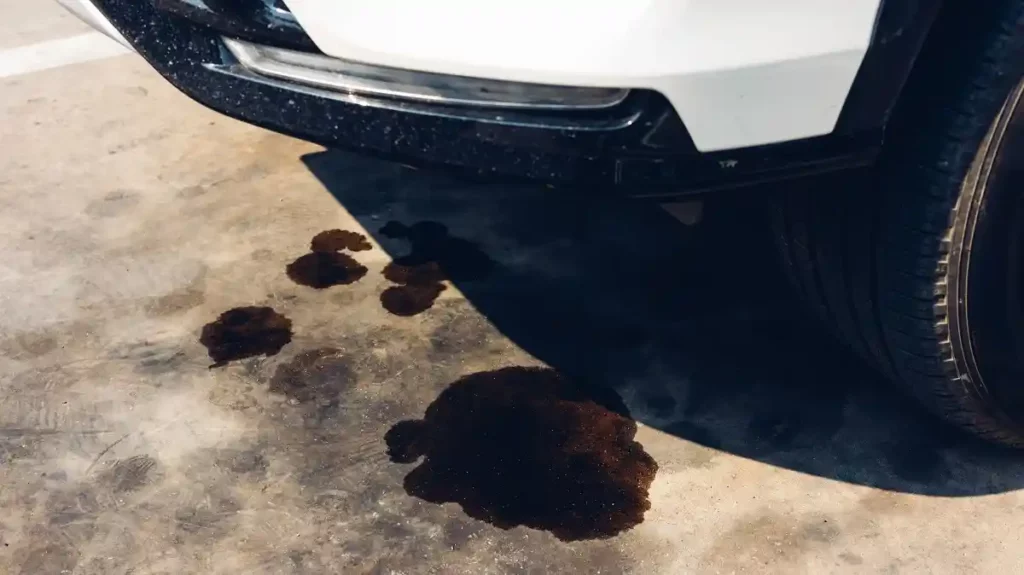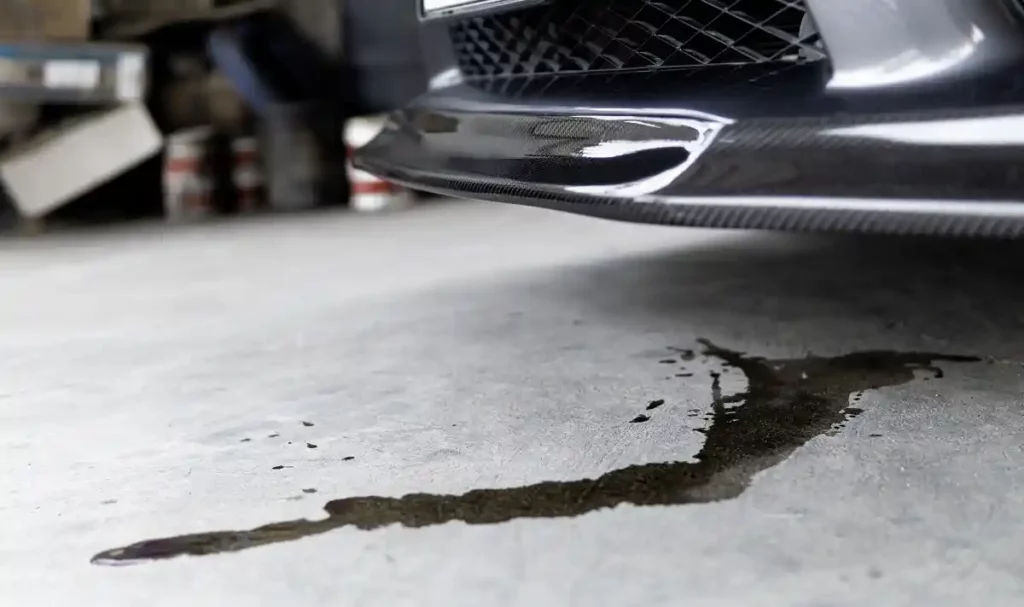Picture this: You’re cruising down the road, enjoying the smooth ride of your beloved car, when suddenly you catch a whiff of something unpleasant—a distinct burning smell. Concerned, you glance at the dashboard, only to find the oil pressure light glaring back at you. Your heart sinks as you realize there might be an oil leak. Ignoring it is not an option, as the consequences could be severe. That’s why it’s crucial to diagnose car oil leaks quickly.
In this guide, we will dig into the world of car oil leaks, exploring the telltale signs and going over a step-by-step guide to identify them promptly. By understanding the basics of oil leaks, recognizing common symptoms, and taking appropriate action, you can save yourself from costly repairs and potential engine damage. So, let’s dive in and learn how to nip oil leaks in the bud.

Understanding the Basics of Car Oil Leaks
Before we dive into diagnosing car oil leaks, let’s first understand what they are and how they occur. Your car’s engine relies on oil for lubrication, which helps reduce friction between moving parts and prevents excessive wear and tear. Over time, due to various factors, such as aging gaskets, degraded seals, or mechanical damage, oil leaks can occur, leading to a loss of oil from the engine.
There are several potential causes of oil leaks in a car. Common culprits include faulty gaskets, such as the valve cover gasket or oil pan gasket, worn-out seals, damaged or loose oil filters, and cracked engine components. It’s essential to note that the location and severity of the leak can vary, depending on the specific cause.
Driving with an oil leak can have serious consequences. Besides the obvious risk of running out of oil, which can cause engine failure, oil leaks can lead to engine overheating, reduced fuel efficiency, and increased emissions. Additionally, the leaked oil can contaminate other engine components and create a fire hazard if it comes into contact with hot surfaces.
Diagnosing and addressing oil leaks promptly can prevent further damage to your engine, extend its lifespan, and ensure optimal performance.
Common Signs of Car Oil Leaks
Identifying the signs of a car oil leak is crucial for early detection and prompt action. Here are some common indicators that can help you determine whether your vehicle is experiencing an oil leak:
- Oil spots or puddles under the car — One of the most apparent signs of an oil leak is the presence of oil spots or puddles on the ground where you park your car. The color of the oil may vary, but it usually appears dark brown or black.
- Burning smell from the engine — If you notice a strong burning odor coming from the engine compartment, it could be an indication that oil is leaking onto hot engine components. The smell is often described as a burnt or acrid odor.
- Low oil level on the dipstick — Regularly checking your engine oil level is essential. If you find that the oil level is consistently low, despite recent oil changes, it could be a sign of an underlying oil leak.
- Engine overheating — Oil helps regulate the temperature of the engine by lubricating and dissipating heat. When there’s an oil leak, the lubrication is compromised, and the engine may start to overheat, leading to potential damage if left unaddressed.
- Unusual engine noises — Insufficient lubrication due to an oil leak can cause increased friction between engine components, resulting in abnormal sounds like knocking, ticking, or grinding. These noises should not be ignored as they can indicate significant engine problems.
If you notice any of these signs, it’s crucial to take immediate action and diagnose the oil leak to prevent further damage to your car’s engine. In the next section, we will provide you with a step-by-step guide to help you diagnose car oil leaks quickly and effectively.
Step-by-Step Guide to Diagnosing Car Oil Leaks

Diagnosing car oil leaks promptly is crucial for maintaining the health and performance of your vehicle’s engine. In this step-by-step guide, we will walk you through the process of identifying and diagnosing oil leaks in your car. By following these steps, you can quickly pinpoint the source of the leak and take appropriate action. So, let’s get started and get to the bottom of those pesky oil leaks.
Step 1: Preparation
Before you begin the oil leak diagnosis, gather the necessary tools and materials. You may need a flashlight, gloves, a clean cloth or paper towels, an oil dye kit (optional), and a drip tray or cardboard to catch any leaked oil. It’s also important to ensure your safety by working on a cool engine and wearing protective eyewear.
If your engine is too contaminated with oil, you’re better off throwing a few cans of brake cleaner at the mess and degreasing the whole engine. This will add a day or two to the whole process, but you should be able to clearly see where the oil is coming from after one or two drives.
Step 2: Locating the Source of the Leak
Start by visually inspecting the engine and surrounding components for any signs of oil residue. Check the valve covers, oil pan, oil filter, and other areas where leaks commonly occur. Look for wet or greasy spots, as well as any dripping or pooling of oil. A flashlight can help you spot oil leaks in hard-to-see areas. Always start from the top of the engine and work your way down.
Make sure to give the PCV valve a good look. Over time, the rubber lines that are integrated into the PCV valve can deteriorate.
If you can’t find anything but you’re still losing oil, make sure to check inside the ignition coil wells. Sometimes the O ring that seals the ignition coil well can fail, causing a substantial leak that is pretty much invisible on the outside.
If you want to make this whole process a lot easier, get yourself some engine oil dye. Pour the die into the engine and go for a short drive. When you return, get a UV light and inspect all of the suspected areas. Any oil that has just leaked out of the engine will glow bright yellow under the UV light.
Step 3: Identifying the Type of Oil Leak
Once you locate the oil residue, try to determine the type of oil leak. Common types include valve cover gasket leaks, oil pan gasket leaks, and rear main seal leaks. Each type has its own characteristics and symptoms.
For example, a valve cover gasket leak may result in oil pooling around the valve covers, while an oil pan leak can lead to oil dripping from the bottom of the engine. Sometimes oil leaks can be deceptive. You’ll see an oil leak appear in a part of your engine, but the real origin of the leak could be somewhere else.
Step 4: Determining the Severity of the Leak
Assess the extent of the oil leak by observing the rate of oil loss and the overall condition of the engine. If the leak is minor and the oil loss is slow, you may have some time before taking action. However, if the leak is severe and the oil loss is rapid, it’s essential to address the issue as soon as possible to prevent engine damage.
Step 5: Taking Appropriate Action
Based on the severity of the leak, determine the appropriate course of action. For minor leaks, consider replacing worn-out gaskets or seals yourself. However, for major or complex leaks, you might be better off seeking professional help from a qualified mechanic. They have the expertise to diagnose and repair the issue accurately, ensuring the long-term health of your vehicle.
Preventive Measures for Car Oil Leaks

While diagnosing and addressing oil leaks is important, it’s equally crucial to take preventive measures to minimize the risk of future leaks. Here are some proactive steps you can take:
- Regularly check and change the engine oil — Follow the manufacturer’s recommendations for oil change intervals and ensure you use the recommended oil grade. Regularly checking the oil level and changing the oil at the specified intervals will help maintain proper lubrication and reduce the likelihood of leaks.
- Maintain proper oil levels — Make it a habit to check your car’s oil level using the dipstick regularly. If you notice a significant drop in oil level between oil changes, it could be an early indication of a leak. Address any abnormalities promptly.
- Inspect and replace worn-out gaskets and seals — Over time, gaskets and seals can deteriorate, leading to potential leaks. Routinely inspect these components during oil changes or whenever you notice signs of leakage. Replace them as needed to ensure a proper seal.
- Monitor engine temperature and pressure — Keep an eye on your car’s temperature gauge to ensure it stays within the normal range. Overheating can put additional stress on gaskets and seals, increasing the risk of leaks. Additionally, maintaining proper oil pressure is essential for preventing leaks, so monitor the oil pressure gauge or warning light.
- Avoid over-tightening oil filter and drain plug — When changing the oil or replacing the oil filter, ensure you don’t over-tighten the oil filter or drain plug. Over-tightening can damage the threads or gaskets, leading to leaks. Follow the manufacturer’s specifications for tightening torque.
- Be cautious with additives or aftermarket products — While some oil additives claim to fix leaks, it’s important to exercise caution. Consult your mechanic or refer to the manufacturer’s recommendations before using any additives or aftermarket products. Incorrect usage may do more harm than good.
Implementing these preventive measures can significantly reduce the risk of car oil leaks and ensure the longevity and optimal performance of your vehicle’s engine.
Fix Your Engine Oil Leaks with Quality Auto Parts!
Diagnosing car oil leaks quickly is essential for maintaining the health of your vehicle’s engine. By being vigilant and recognizing the signs of oil leaks, you can take appropriate action to prevent further damage.
Additionally, don’t forget to take preventive measures to minimize the risk of oil leaks. Regular maintenance, proper oil levels, and careful monitoring of engine temperature and pressure can go a long way in preventing leaks. If they do happen, make sure to use high-quality replacement parts when applying a fix. Here at eEuroparts.com, we offer a wide range of seals, gaskets, and other car parts made by some of the best brands in the business. Head over to our store and find parts that are a guaranteed fit for your vehicle!


